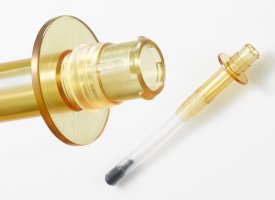At the NPE 2009 in Chicago, Dymotek and Arburg showed a two-component Allrounder 570 A with the Multilift V robotic system for processing thermoplastic and liquid silicone (LSR) integrated in a complex production cell. This involves combining complex mould engineering with precision Arburg technology: a two-station mould (4+4 cavities) with a radiation treatment, indexing cores, demoulding unit, and a fully electric Allrounder with flexible robotic system technology. Further project partners were Elmet (mould, LSR pump), Momentive Performance Materials (LSR), Kiki (assembly, leakage testing) and Sabic (Ultem thermoplastic).
 Dymotek demonstrated its capability with the precision production of a very precise and disposable fluid pump assembly with an integrated seal.
Dymotek demonstrated its capability with the precision production of a very precise and disposable fluid pump assembly with an integrated seal.
Dymotek, a specialist for the production of LSR and thermoplastic parts, demonstrated the precision production of a very precise and disposable fluid pump assembly with an integrated seal on the Arburg stand. The electric two-component Allrounder 570 A with a clamping force of 2,000 kN (220 tons) is equipped for processing silicone and has two size 170 (3.7 oz) injection units. In order to meet product requirements such as watertightness and resistance to corrosion and extreme temperatures, liquid silicone was chosen for the pump geometry as well as the seals for the pump. The moulded part weight is 14.46 grams (0.51 oz) and the cycle time 45 seconds.
The Allrounder is equipped with a Multilift V vertical robotic system that removes the moulded parts from the demoulding unit of the mould and transfers them to an assembly and function testing station. The injection units are arranged in an L-configuration. The thermoplastic is injected from the rear of the machine, while the LSR is injected in the conventional manner through the fixed platen.
The Ultem moulded components are treated with radiation automatically in cycle to aid in the bonding of the silicone to the Ultem.
The injection unit for processing the LSR features liquid temperature control and is equipped with a special LSR mixing and conveying screw and a spring-actuated disc-type non-return valve. A total of 21 electric heating regulation circuits ensure optimum mould heating, 15 of these are located on the fixed platen, and six on the moving platen. Eight cooling circuits are available for operation of the cold runner system.
The production process in detail
The 4+4-cavity mould features an indexing core plate that is rotated by means of a hydraulic core pull. In the first operation, four Ultem thermoplastic pre-moulded parts are produced simultaneously in the lower half of the mould and are then irradiated with light to ensure better adhesion of the silicone. After rotation, the silicone areas (pump and seal) are overmoulded onto the Ultem through two valve gates per cavity in the second station.
After the moulding process is complete, the four disposable pumps are removed by the demoulding unit of the mould. This transfers the four finished parts to the vertically operating Multilift V robotic system equipped with four grippers. This turns the moulded parts through 180 degrees and moves to an assembly station. Here the nozzles, a separate moulded component, provided by a feeding system, are inserted into the silicone pump from below. They are first inserted, then pushed over a sealing lip and finally pressed into the right position from above by means of a lifting cylinder.
In the next operation, the completed pump assemblies are 100% tested for correct pump function via a pressure decay test and to ensure there are no leaks. A specific pressure must be held for approximately two seconds. If they are found to be below the minimum acceptance value, the parts are judged to be faulty and are placed in a reject bin. If the values are within the predefined tolerance range, the finished parts are placed on a conveyor for cooling and packaging.
Complex mould engineering
The special challenge in terms of machine and mould in two-component applications with thermoplastic and LSR consists primarily in the effective separation of the hot and cold areas within the mould. This is how controlled vulcanisation of the LSR component is reliably assured. On the 4+4-cavity mould, the lower area with the hot runner system serves to produce the Ultem thermoplastic pre-moulded part and the upper area with the cold runner system is used to produce the pump and the seal without silicone runner waste. Another special feature is that the hydraulic needle-type shut-off nozzle is located in the mould itself. The mould also features a demoulding unit which removes the parts from the mould and transfers them to the Multilift V.
Selogica machine control system ensures ease of operation
The entire system, comprising the Multilift V robotic system, the LSR dosage and vacuum system, as well as the three pressurised oil temperature control devices, each with a peak output of 160 degrees Celsius, is programmed and controlled via the Selogica 'direct' machine control system with touchscreen. The Multilift is graphically integrated in the control system with dedicated sequences, as is the LSR processing, via extended symbols. The remaining peripherals are connected to the Selogica control system via interfaces.
With this production cell for disposable fluid pump assemblies, Dymotek demonstrate its expertise in the production of two component silicone and thermoplastic parts. At the same time Arburg offers impressive evidence of the flexibility and versatility of the Allrounders, Multilift robotic systems, central Selogica control system, the implementation of complex project systems and its expertise in the field of multi-component injection moulding.